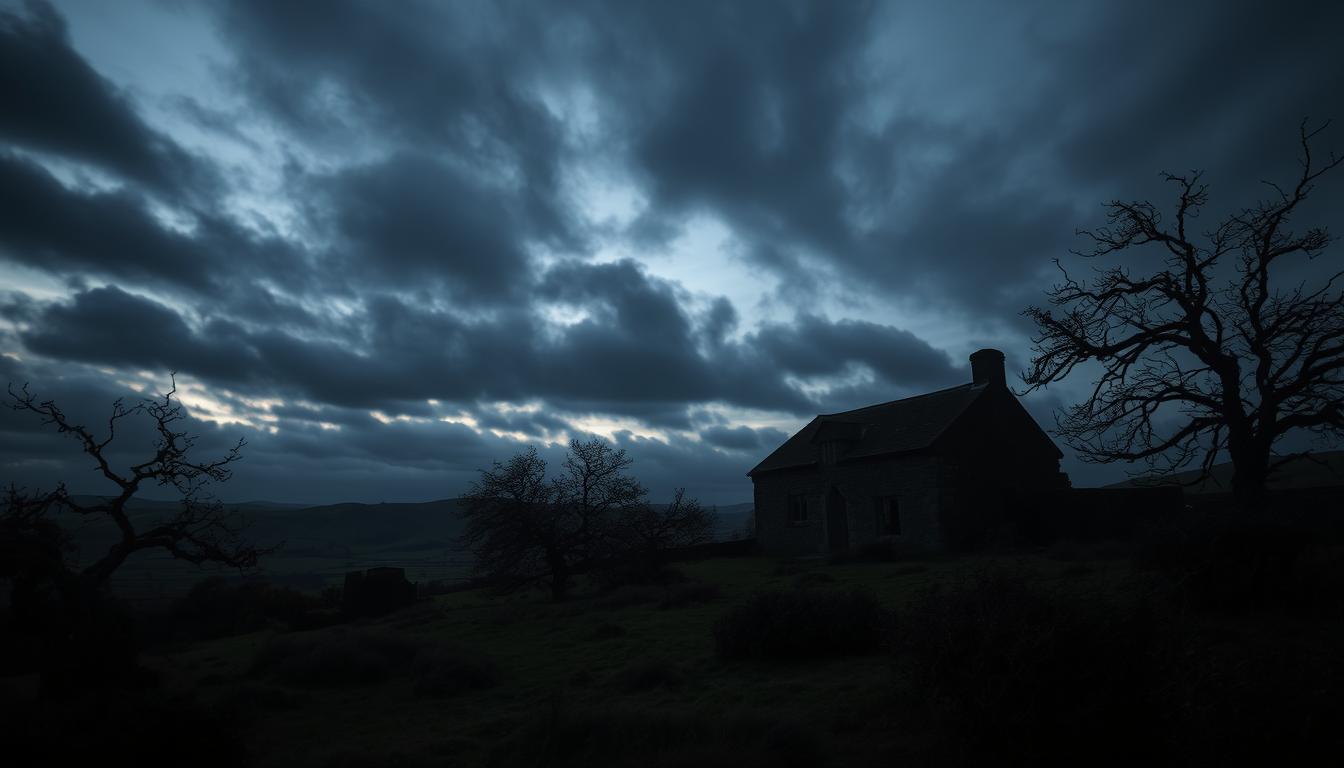Emily Brontë’s classic novel, Wuthering Heights, is a timeless tale of love and revenge, set against the backdrop of the Yorkshire moors. Published in 1847, this iconic novel has captivated readers with its complex characters and exploration of the human experience. At its core, Wuthering Heights is a story about the intense and often destructive nature of love, as embodied by the tumultuous relationship between Catherine Earnshaw and Heathcliff.
As we delve into the world of Wuthering Heights, we find ourselves drawn into a realm of passion and revenge, where the boundaries between love and hate are constantly blurred. This classic novel by Emily Brontë is a must-read for anyone interested in exploring the complexities of the human heart. With its richly atmospheric setting and complex characters, Wuthering Heights is a novel that continues to haunt and inspire readers to this day.
Key Takeaways
- Wuthering Heights is a classic novel written by Emily Brontë, published in 1847.
- The novel explores themes of love, revenge, and nature, set against the backdrop of the Yorkshire moors.
- The intense and complex relationship between Catherine Earnshaw and Heathcliff drives the narrative of the novel.
- Wuthering Heights is a timeless tale of love and revenge, with a richly atmospheric setting and complex characters.
- The novel continues to be a must-read for anyone interested in exploring the complexities of the human heart.
- Emily Brontë’s writing style and the novel’s non-linear narrative structure add to its enduring appeal.
- Wuthering Heights is a significant work of English literature, with a lasting impact on the literary world.
Introduction to Wuthering Heights
Published in 1847, Wuthering Heights is a classic of English literature, known for its complex and often controversial exploration of love, revenge, and societal expectations. As a gothic novel, it has had a significant impact on the literary world, influencing many other authors and works of literature.
The novel’s significance in English literature cannot be overstated, with its unique blend of Gothic and Romantic elements. Emily Brontë’s writing style, which includes the use of multiple narrators and non-linear storytelling, adds to the novel’s complexity and depth.
Overview of the Novel’s Themes
The plot of Wuthering Heights revolves around the interwoven relationships between the Earnshaws, Lintons, and their foster son, Heathcliff. The novel explores themes of love, revenge, and class, all set against the backdrop of the Yorkshire moors.
Significance in Literature
Wuthering Heights has been widely praised for its literary merit, with many considering it one of the greatest novels ever written in English. Its influence can be seen in many other works of literature, and it continues to be widely read and studied today.
Emily Brontë’s Writing Style
Emily Brontë’s writing style is characterized by her use of poetic language and her exploration of the human psyche. Her use of multiple narrators and non-linear storytelling adds to the novel’s complexity and depth, making it a classic of English literature.
The Complex Relationship of Catherine and Heathcliff
The relationship between Catherine and Heathcliff is a central theme in Wuthering Heights, and it is characterized by intense passion, destructive obsession, and a struggle for identity and control. Through a literary analysis of their bond, it becomes clear that their connection transcends conventional descriptions, portraying a relationship that oscillates between love, obsession, and interdependence.
Heathcliff and Catherine’s childhood depicts them as mental twins with common interests and wild personalities, emphasizing their deep connection. However, Catherine’s societal expectations lead to a transformation into a traditional “good girl,” while Heathcliff resists conforming to social norms, causing a rift in their relationship. This dynamic is a key aspect of their literary analysis, as it highlights the conflict between ethics and desire.
The concept of a ‘twin flame’ bond between Heathcliff and Catherine has intrigued readers and critics, sparking varied interpretations. Their love story undergoes three stages: innocent love, wavering love, and tragic love, highlighting the complexity and evolution of their relationship. This complex dynamic is a key aspect of the literary analysis of Wuthering Heights, and it is characterized by the intense passion and destructive tendencies of Heathcliff and Cathy.
The Role of Nature in Wuthering Heights
The Yorkshire moors play a significant role in the novel, serving as a reflection of the characters’ emotions and embodying supernatural elements. The wild, untamed landscape mirrors the passions of Heathcliff and Catherine, creating an atmosphere of uncertainty and chaos.
In the context of a gothic novel, the Yorkshire moors act as a boundary between civilization and wildness, highlighting the inner conflict and destruction that can result from societal norms. The literary analysis of the novel reveals that the moors are not just a setting, but a character in their own right, influencing the emotions and actions of the characters.
Some key aspects of the role of nature in Wuthering Heights include:
- The moors as a symbol of freedom and liberation for characters like Catherine and Heathcliff
- The use of weather patterns to mirror emotional states, such as stormy weather accompanying conflict or heightened emotions
- The contrast between the timelessness of the moors and the fleeting nature of human lives
The literary analysis of the novel highlights the importance of the Yorkshire moors as a setting and a character, influencing the emotions and actions of the characters. The gothic novel genre is characterized by its use of nature as a powerful literary device, and Wuthering Heights is a prime example of this.
Key Characters and Their Motivations
In the novel Wuthering Heights, Emily Brontë masterfully weaves a complex web of characters, each driven by their own distinct motivations. At the heart of the story lies the tumultuous relationship between Heathcliff and Cathy, a bond that defies conventional norms and societal expectations. Through a literary analysis of these characters, we gain insight into the psychological and emotional depths that drive the narrative forward.
A closer examination of Heathcliff reveals a multifaceted character, often perceived as an anti-hero. His actions are motivated by a deep-seated desire for love and revenge, stemming from the mistreatment he suffered at the hands of those around him. In contrast, Cathy is torn between her wild, untamed nature and the pressures of societal conformity. This internal conflict ultimately leads to a tragic demise, as she becomes trapped in a loveless marriage with Edgar Linton.
Supporting characters, such as Nelly Dean and Hindley Earnshaw, play pivotal roles in shaping the narrative. Their actions and decisions influence the lives of Heathcliff and Cathy, often with devastating consequences. A thorough literary analysis of these characters and their motivations provides a deeper understanding of the novel’s intricate plot and the themes that underlie it, including the destructive power of revenge and the redemptive power of love.
Love and Revenge: Intertwined Motifs
In the novel Wuthering Heights, Emily Bronte masterfully weaves together the themes of love and revenge, creating a complex narrative that explores the destructive nature of unchecked emotions. The love between Catherine and Heathcliff, although intense, is never consummated, and instead, it fuels Heathcliff’s desire for vengeance against those who wronged him.
A closer examination of the novel reveals that Heathcliff’s actions are predominantly motivated by a desire for revenge, as seen in his treatment of Hindley and the Lintons. This cycle of vengeance is perpetuated by Heathcliff’s words, “He seeks no revenge on you; that’s not the plan. The tyrant grinds down his slaves and they don’t turn against him; they crush those beneath them,” showcasing a cycle of suffering and oppression fueled by vengeful desires. For a deeper understanding of the novel’s themes, visit Wuthering Heights quotes and analysis.
The Consequences of Passionate Love
The consequences of passionate love are a dominant theme in Wuthering Heights, as seen in the tumultuous relationship between Catherine and Heathcliff. Their love is depicted through the quote, “He’s more myself than I am. Whatever our souls are made of, his and mine are the same,” illustrating a deep spiritual connection that transcends physical love. This intense love ultimately leads to a cycle of revenge and destruction, highlighting the devastating consequences of unchecked emotions.
Love as a Catalytic Force
Love acts as a catalytic force in the novel, driving character actions and plot developments. The relationship between young Catherine and Hareton is portrayed as a milder version of the love between Cathy and Heathcliff, poised for a happier ending. This contrast highlights the redemptive power of love, demonstrating its ability to break the cycle of revenge and destruction.
| Theme | Description |
|---|---|
| Love | A complex and intense emotion that drives character actions |
| Revenge | A destructive cycle of vengeance that perpetuates suffering and oppression |
| Redemption | The possibility of breaking the cycle of revenge through the power of love |
Through a literary analysis of Wuthering Heights, it becomes clear that Emily Bronte’s masterpiece is a thought-provoking exploration of the human experience, delving into the complexities of love, revenge, and redemption. As we reflect on the novel’s themes, we are reminded of the enduring power of love to both destroy and redeem.
Ghosts and the Supernatural Elements
In the context of a gothic novel, supernatural elements play a significant role in shaping the narrative and exploring themes of love, loss, and the human condition. In Wuthering Heights, Emily Brontë masterfully weaves together elements of the paranormal to create a rich and haunting atmosphere, characteristic of English literature.
A key aspect of the novel’s supernatural elements is the ghostly presence of Catherine, which serves as a catalyst for the events that unfold. Through literary analysis, it becomes clear that Brontë uses Catherine’s ghost to symbolize the enduring power of love and the devastating consequences of its loss. The supernatural elements in the novel also serve to blur the lines between life and death, adding depth and complexity to the narrative.
Some notable features of the supernatural elements in Wuthering Heights include:
- The first appearance of Catherine’s ghost, which sets the tone for the rest of the novel
- The role of the moorlands in shaping the supernatural atmosphere
- The use of vivid descriptions and Yorkshire dialect to make supernatural occurrences appear more believable
Overall, the supernatural elements in Wuthering Heights are a crucial aspect of the novel’s gothic novel identity, and their analysis provides valuable insights into the themes and motifs that underpin the narrative. Through a careful literary analysis of these elements, readers can gain a deeper understanding of the novel’s significance within the context of English literature.
| Supernatural Element | Significance |
|---|---|
| Catherine’s ghost | Symbols the enduring power of love and the devastating consequences of its loss |
| The moorlands | Shapes the supernatural atmosphere and serves as a backdrop for the events of the novel |
| Vivid descriptions and Yorkshire dialect | Makes supernatural occurrences appear more believable and immersive |
The Structure of Wuthering Heights
Emily Bronte’s classic novel, Wuthering Heights, is known for its complex narrative structure, which adds to the overall suspense and intrigue of the story. The novel employs a dual narrative structure, with two different perspectives at varying points in time, allowing for a deeper exploration of character motivations and themes. This literary analysis will examine the role of the primary narrators, Mr. Lockwood and Nelly Dean, and how their perspectives shape our understanding of the story.
The use of a nonlinear narrative creates suspense and allows for a more detailed and layered storytelling experience. The narrative technique of Wuthering Heights combines mystery, suspense, and emotional entanglements to captivate readers. The story begins around the end of 1801, and the dates within the story are meticulously woven into the narrative to depict a clear timeline.
Nonlinear Narrative and Its Effects
The incidents in Wuthering Heights extend over a period of more than thirty years, and the symmetry of the pedigree within the story reflects three generations with an absolute symmetry of relationships. The narrative complexity is increased by characters like Mr. Lockwood, Dinnery, and others, allowing for a more detailed and layered storytelling experience.
The Role of Narration through Lockwood and Nelly
Lockwood serves as an outsider narrator, framing the story, while Nelly Dean, a homodiegetic narrator, contributes a narrative likened to an English folk ballad. Lockwood’s narrative is the outer framework incorporating eyewitness accounts of Nelly’s story. The analysis of narrators highlights their individual forces shaping Brontë’s novel.
Foreshadowing and Its Importance
The use of foreshadowing is crucial in building tension and connecting different parts of the narrative. The narrative technique of Wuthering Heights combines mystery, suspense, and emotional entanglements to captivate readers. This classic novel has been recognized as one of the “Ten Best Novels in World Literature” by Maugham, a renowned contemporary British novelist in 1948, and its unique structure and narrative technique continue to be the subject of literary analysis.
| Narrator | Perspective | Contribution to the Story |
|---|---|---|
| Lockwood | Outsider | Framing the story |
| Nelly Dean | Homodiegetic | Contributing a narrative likened to an English folk ballad |
Themes of Class and Social Inequality
In the novel Wuthering Heights, Emily Brontë explores the themes of class and social inequality, which are central to the English literature of the time. Through the contrast between the Earnshaws and the Lintons, Brontë highlights the social hierarchy of 19th-century England, where the upper class held significant power and influence.
The impact of class on relationships is a significant aspect of the novel, as seen in the complex and often fraught interactions between characters from different social backgrounds. A literary analysis of Wuthering Heights reveals that class differences drive many of the conflicts and tensions in the story, ultimately shaping the characters’ experiences and outcomes.
Some key aspects of class and social inequality in Wuthering Heights include:
- The social hierarchy between the Earnshaws and Lintons, with the Earnshaws representing the middle class and the Lintons representing the upper class.
- The impact of class on relationships, particularly between Catherine and Heathcliff, who are from different social backgrounds.
- The class struggles and conflicts that drive the plot of the novel, ultimately leading to tragic consequences.
Through its exploration of class and social inequality, Wuthering Heights provides a thought-provoking commentary on the social context of 19th-century England, making it a significant work of English literature that continues to resonate with readers today.
Conclusion: The Enduring Legacy of Wuthering Heights
The profound impact of Emily Brontë’s Wuthering Heights on literature and popular culture is undeniable. This classic novel has inspired generations of writers, who have been captivated by its complex characters, intense emotions, and timeless themes.
Influence on Modern Literature
The innovative narrative structure and psychological depth of Wuthering Heights have left an indelible mark on the literary landscape. Countless authors have drawn inspiration from Brontë’s exploration of passion, revenge, and the human condition, incorporating these elements into their own works. The novel’s influence can be seen in the writings of modern masters, who have continued to grapple with the complexities of love and social class.
Adaptations in Film and Theatre
The enduring appeal of Wuthering Heights has led to numerous adaptations in film, television, and stage productions. These interpretations have brought Brontë’s beloved characters and their turbulent story to new audiences, allowing the work to transcend the boundaries of the printed page. From classic cinematic renditions to contemporary stage productions, the novel’s timeless quality has been celebrated and reimagined for each generation.
Why Wuthering Heights Remains Relevant Today
Even over a century and a half after its publication, Wuthering Heights continues to captivate readers and scholars alike. The novel’s exploration of universal themes, such as love, revenge, and the human condition, resonates with modern audiences. Brontë’s vivid portrayal of the Yorkshire moors and her deeply complex characters continue to foster discussion and reflection, making Wuthering Heights an enduring classic that endures the test of time.















